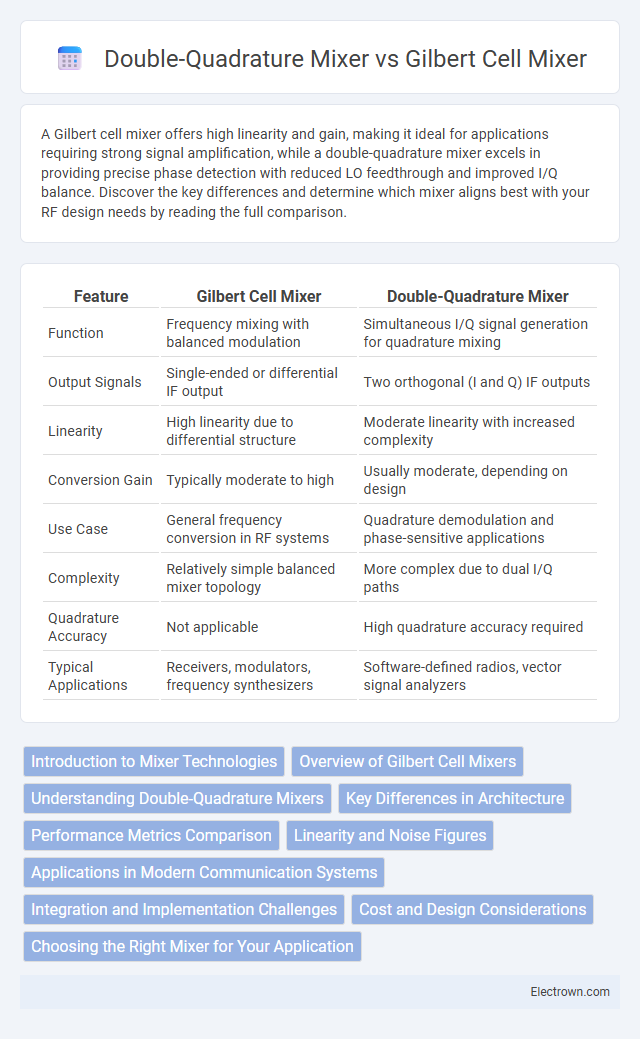A Gilbert cell mixer offers high linearity and gain, making it ideal for applications requiring strong signal amplification, while a double-quadrature mixer excels in providing precise phase detection with reduced LO feedthrough and improved I/Q balance. Discover the key differences and determine which mixer aligns best with your RF design needs by reading the full comparison.
Table of Comparison
| Feature | Gilbert Cell Mixer | Double-Quadrature Mixer |
|---|---|---|
| Function | Frequency mixing with balanced modulation | Simultaneous I/Q signal generation for quadrature mixing |
| Output Signals | Single-ended or differential IF output | Two orthogonal (I and Q) IF outputs |
| Linearity | High linearity due to differential structure | Moderate linearity with increased complexity |
| Conversion Gain | Typically moderate to high | Usually moderate, depending on design |
| Use Case | General frequency conversion in RF systems | Quadrature demodulation and phase-sensitive applications |
| Complexity | Relatively simple balanced mixer topology | More complex due to dual I/Q paths |
| Quadrature Accuracy | Not applicable | High quadrature accuracy required |
| Typical Applications | Receivers, modulators, frequency synthesizers | Software-defined radios, vector signal analyzers |
Introduction to Mixer Technologies
Mixer technologies such as the Gilbert Cell Mixer and Double-Quadrature Mixer are fundamental components in radio frequency (RF) systems, converting signals to different frequencies for processing. The Gilbert Cell Mixer utilizes a transconductance stage followed by a multiplication stage, offering strong linearity and high gain with balanced differential inputs, making it ideal for high-frequency applications. The Double-Quadrature Mixer generates in-phase and quadrature outputs simultaneously, enhancing signal demodulation and image rejection, which may improve the performance of your communication system in complex modulations.
Overview of Gilbert Cell Mixers
Gilbert Cell mixers are widely used in RF and microwave circuits for frequency conversion due to their balanced structure, which provides high linearity and good isolation between ports. These mixers utilize a transconductance stage followed by a double-balanced switching quad, enabling efficient mixing with low distortion and improved gain compared to simpler mixers. The robust design of Gilbert Cell mixers makes them ideal for applications requiring precise signal processing and minimal spurious output.
Understanding Double-Quadrature Mixers
Double-quadrature mixers offer improved phase accuracy and image rejection compared to Gilbert cell mixers by combining two orthogonal mixing paths with precise 90-degree phase shifts. This design enables better suppression of unwanted sidebands and enhances signal integrity in complex modulation schemes, critical in modern communication systems. You can achieve more efficient frequency conversion with double-quadrature mixers, especially in applications requiring precise I/Q signal processing.
Key Differences in Architecture
The Gilbert Cell Mixer features a transconductance stage followed by a switching quad for frequency conversion, enabling balanced and linear mixing with high port-to-port isolation. In contrast, the Double-Quadrature Mixer incorporates two quadrature mixer cores, providing improved image rejection and phase accuracy by processing in-phase and quadrature components simultaneously. Your choice depends on whether you prioritize linearity and simplicity in the Gilbert Cell architecture or enhanced quadrature performance from the Double-Quadrature Mixer design.
Performance Metrics Comparison
The Gilbert Cell Mixer offers high linearity and gain, making it ideal for applications requiring strong signal integrity and minimal distortion, with typical IP3 values ranging from +10 to +20 dBm. Double-Quadrature Mixers provide superior phase accuracy and improved sideband suppression, enhancing signal quality in complex modulation schemes, often achieving sideband suppression levels greater than 30 dB. Your choice depends on whether linearity or phase performance is more critical for your system's performance requirements.
Linearity and Noise Figures
The Gilbert Cell Mixer offers moderate linearity with noise figures typically ranging from 8 to 12 dB, making it suitable for applications requiring balanced trade-offs between performance and complexity. In contrast, the Double-Quadrature Mixer provides superior linearity and lower noise figures, often below 7 dB, enhancing signal fidelity in high-performance RF systems. The improved noise figure and linearity in Double-Quadrature Mixers result from their advanced topology, which effectively cancels even-order distortion and reduces noise contributions.
Applications in Modern Communication Systems
The Gilbert Cell Mixer excels in applications requiring high linearity and gain control, such as in RF front-end modules for cellular and satellite communications. The Double-Quadrature Mixer, offering precise phase and amplitude balance, is ideal for advanced modulation schemes in software-defined radios and MIMO systems. Both mixers enhance signal integrity and spectral efficiency but cater to distinct system requirements in modern wireless communication infrastructures.
Integration and Implementation Challenges
Gilbert Cell Mixers offer compact integration within monolithic microwave integrated circuits (MMIC) due to their balanced core and differential structure, yet require careful biasing and linearity control to avoid distortion. Double-Quadrature Mixers, while providing enhanced image rejection and phase accuracy for complex signal modulation, face implementation challenges such as increased circuit complexity and precise quadrature phase generation, which demand advanced calibration methods. Both architectures necessitate careful layout optimization to minimize parasitic effects and substrate coupling, crucial for high-frequency performance in integrated RF front-ends.
Cost and Design Considerations
The Gilbert Cell Mixer generally offers a lower cost due to its simpler design and widespread integration in IC fabrication, making it suitable for mass-produced RF applications. Its design involves fewer passive components and can be efficiently fabricated using standard CMOS processes, reducing overall production expenses. The Double-Quadrature Mixer, while providing superior phase accuracy and improved signal rejection, requires more complex circuitry and precise component matching, leading to higher design and manufacturing costs that may not justify its use in cost-sensitive applications.
Choosing the Right Mixer for Your Application
Selecting the right mixer depends on the specific application requirements such as linearity, isolation, and frequency range. Gilbert Cell Mixers offer high linearity and gain suitable for applications like RF front-end modules and low-noise amplification. Double-Quadrature Mixers provide superior phase accuracy and image rejection, making them ideal for complex modulation schemes and coherent detection systems.
Gilbert Cell Mixer vs Double-Quadrature Mixer Infographic

 electrown.com
electrown.com